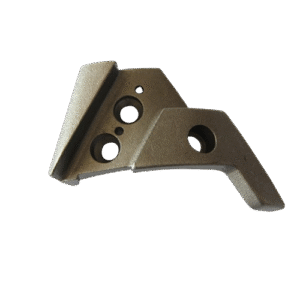What is Metal Forging
What is Metal Forging? A Comprehensive Guide
Metal forging, specifically die forging (also known as closed-die forging), is a advanced manufacturing process where a metal piece, known as a blank or billet, is shaped by applying compressive forces within a set of dies. The dies contain a precut profile of the desired part. Unlike open-die forging, which is for larger, simpler shapes, die forging is ideal for producing high-strength, complex, and small to medium-sized forging parts with exceptional dimensional accuracy and repeatability. This process fundamentally alters the metal’s internal grain structure, aligning it with the part’s geometry, which results in superior strength and toughness compared to parts made by casting or machining.

The Metal Forging Process (Die Forging)
The die forging process for small components is a precise and controlled sequence:
Billet Preparation: The raw material (bar stock) is cut into precise-sized billets based on the final part’s volume and weight.
Heating: The billets are heated in a furnace to a specific “forging temperature” to make the metal malleable.
Forging: The heated billet is transferred to the forging die. A mechanical press or hammer applies high pressure, forcing the metal to flow and completely fill the die cavity.
Trimming: Excess metal, called “flash,” which escapes from the die seams, is trimmed off in a separate press.
Heat Treatment: The forged part is often heat-treated (e.g., annealing, normalizing, quenching, and tempering) to achieve the desired mechanical properties like hardness and strength.
Finishing: Secondary operations like shot blasting, grinding, machining, or coating are performed to meet final dimensional and surface finish requirements.
Forging Temperatures for Different Metals
Temperature is critical for successful forging. It must be high enough for proper metal flow but not so high as to cause damage.
Carbon Steel: 1100°C – 1250°C (2012°F – 2282°F). The exact temperature depends on the carbon content, with lower-carbon steels requiring higher temperatures.
Stainless Steel: 1150°C – 1260°C (2102°F – 2300°F). Austenitic stainless steels (like 304) are commonly forged, but they require careful control to prevent carbide precipitation.
Aluminum Alloy: 370°C – 475°C (700°F – 887°F). Aluminum forges at a much lower temperature and requires strict control to avoid overheating, which can cause weakness.

Key Considerations in the Metal Forging Process
To ensure high-quality small forged parts, several factors must be meticulously controlled:
Die Design and Maintenance: The die is the heart of the process. It must be precisely machined and regularly maintained to prevent wear and ensure part accuracy.
Temperature Control: Consistent and uniform heating is essential. Overheating can cause “burning” (grain boundary oxidation), while under-heating leads to inadequate die fill and internal cracks.
Material Quality: Using high-quality, defect-free billets is crucial for the integrity of the final part.
Lubrication: Dies are lubricated to facilitate metal flow, prevent sticking, and extend die life.
Draft Angles: Dies are designed with slight angles to allow for the easy ejection of the finished part.
Industries that Rely on Metal Forging
The superior strength and reliability of die-forged components make them indispensable in critical applications across numerous industries:
Automotive: Connecting rods, transmission gears, crankshafts, and wheel hubs.
Aerospace: Turbine blades, engine mounts, landing gear components, and structural brackets.
Oil & Gas: Valves, fittings, drill bits, and downhole tool components.
Industrial Machinery: Gears, shafts, levers, and heavy equipment parts.
Tools and Hardware: Wrenches, pliers, hammers, and high-strength fasteners.
Key Benefits of Metal Forging
Choosing die forging for your components offers significant advantages:
Exceptional Strength and Toughness: The forging process refines the metal’s grain structure, resulting in high impact and fatigue strength.
Reliability and Consistency: Die forging produces parts with minimal internal defects, ensuring high reliability and consistent performance part-to-part.
Cost-Effectiveness for High Volume: While die costs can be high, the process is highly efficient for mass production of small parts.
Superior Material Utilization: The process minimizes waste, especially when combined with near-net-shape techniques.
Improved Microstructural Integrity: Forgings are free from the porosity and inclusions common in cast parts.
Custom Metal Forging Services: Your Design, Our Expertise
We specialize in providing custom die forging solutions for small, precision forging parts. Our capabilities allow us to work closely with clients to manufacture components that meet their exact specifications.
Whether you have a ready-to-use design or a concept, our engineering team can assist with:
Material Selection: Recommending the optimal alloy for your application.
Design for Manufacturability (DFM): Optimizing your part design for the forging process to enhance performance and reduce cost.
Full Process Management: Managing the entire project from prototyping and tooling creation to mass production and finishing.
Contact us today to discuss your custom metal forging needs. Let us help you forge a stronger solution for your business.
